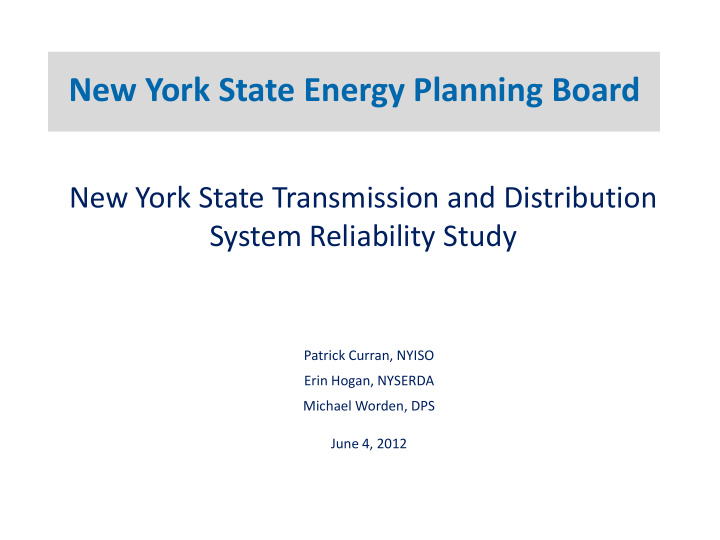



New York State Energy Planning Board New York State Transmission and Distribution System Reliability Study Patrick Curran, NYISO Erin Hogan, NYSERDA Michael Worden, DPS June 4, 2012
T&D Reliability Study Highlights Introduction and Overview Transmission System Reliability Distribution Reliability Investment and Expenditures Environmental Regulations T&D Reliability Impacts from Policy Future T&D Reliability Issues Key Findings and Recommendations 2 2
Overview of The Electric System
Fundamental Reliability Principle Generation 4 4
New York State Generation Source: NYISO, 2012 5 5
New York State High Voltage Transmission HVDC Source: NYISO, 2012 6 6
New York Transmission Owner Service Areas 7 7 Source: DPS, 2012
Historical Load Growth By Aggregated Wholesale Energy Load Zone 90,000 80,000 70,000 60,000 MWH 50,000 40,000 30,000 20,000 2000 2001 2002 2003 2004 2005 2006 2007 2008 2009 2010 2011 Zones A-E Zones F-I Zones J-K 8 8
Transmission System Reliability
Reliability Oversight FERC NERC NPCC NYSRC PSC Market Transmission NYISO Participants Owners 10 10
NERC Interconnections 11 11 Source: NERC, 2012
Transmission Reliability Metrics Planning Metrics – Resource Adequacy • Loss of Load Expectation • 1 in 10 years – System Security Analysis or Operation Reliability • N-1; N-1-1 Operations Metrics – Uncontrolled Loss of Load Event 12 12
Transmission System Planning NYISO – Area Transmission Review – Comprehensive System Planning Process • Local Transmission Planning Process • Reliability Needs Assessment • Comprehensive Reliability Plan • Congestion Assessment and Resource Integration Study Regional and Interregional – EIPC – Northeast Coordinated Plan – Eastern Interconnection Assessment Group – NPCC Overall Transmission Assessment – NERC 2011 Long-Term Reliability Assessment 13
Transmission System Operations Seasonal Operating Studies – Assesses transfer limits on key interface Day Ahead Operating Plan – Security Constrained Unit Commitment Real Time Operations – Real Time Commitment and Dispatch System Operating States – Normal – Warning – Alert – Major Emergency – Restoration 14
Reliability Issues Identified in Planning Studies NERC – 2011 Long-Term Reliability Assessment – 2011 Risk Assessment of Reliability Performance Report 2010 Comprehensive Reliability Plan – No reliability violations identified in base case – Risks identified in sensitivities State Transmission Assessment and Reliability Study – Aging infrastructure – Opportunities to increase transfer capacity 15 15
New York State Transmission Assessment and Reliability Study Source: STARS, 2012 16 16
Distribution System Reliability
Distribution Reliability Annual Reliability Report Reliability Improvements Power Quality Issues Electric Utility Emergency Plans Storm Mitigation 18 18
Distribution Reliability Metrics Customer Average Interruption Duration Index (CAIDI) Number of Customer Hours/ Number of Customers Affected System Average Interruption Frequency Index (SAIFI) Number of Customer Affected/Number of Customers Served 19 19
Distribution Performance NYS SAIFI For Radial and Network NYS CAIDI For Radial and Network 1.60 9.00 8.00 1.40 7.00 1.20 6.00 1.00 5.00 0.80 4.00 0.60 3.00 0.40 2.00 0.20 1.00 0.00 0.00 2007 2008 2009 2010 2011 2007 2008 2009 2010 2011 Draft Draft Radial With Storms Radial W/O Storms Network Radial With Storms Radial W/O Storms Network Note: 2011 Values are draft, does not include LIPA outage data from Hurricane Irene 20 20
Causes of Distribution Interruptions Radial Interruptions Network Interruptions Cust Prearrang Unknown Equip Lightning ed 8% 4% Tree 5% 0% 27% Accident Cust 1% Equip 1% Equipment 7% Overload Prearrang 3% ed 14% Mains Error 7% 0% Accident Services 13% Equipment 81% 40% 21 21
Number of Customer-Hour Interruptions 80,000,000 70,000,000 60,000,000 50,000,000 40,000,000 30,000,000 20,000,000 10,000,000 0 2007 2008 2009 2010 2011 Draft Major Storm Related Outages Note: 2011 Values are draft, does not include LIPA outage data from Hurricane Irene 22 22
Investment and Expenditures
Utility Capital Expenditure ($000s) 3,000,000 2,500,000 2,000,000 Actual 1,500,000 Plan 1,000,000 500,000 0 2004 2005 2006 2007 2008 2009 2010 2011 2012 2013 2014 2015 24 24
Electric O&M Expenses ($000s) 1,200,000 1,000,000 800,000 600,000 Trans Dist 400,000 200,000 0 2004 2005 2006 2007 2008 2009 2010 25 25
Environmental Regulations
Environmental Regulations Existing Rules – NOx RACT Rule – Best Available Retrofit Technology (BART) Rule – Utility MACT Rule – Best Technology Available (BTA) Policy New and Future Rules – Cross-State Air Pollution Rule – Cooling Water Intake Structures – Coal Combustion Residuals – CO 2 Emission Allowance 27
Impacts to Reliability
Reliability Impacts From Policies Load – Energy Efficiency – Large Load Growth – Other Load Varying Mechanisms Generation – Renewable Portfolio Standard – Distributed Generation Transmission & Distribution – Bulk Electric System Definition – Performance Rate Making, Multi-Year Rate Agreements, and other Departures from Traditional Regulatory Mechanisms Regulatory – Corporate Reorganization of Electric Utilities 29
Possible Future Reliability Issues Generation T&D Load External Forc es • Retirements • Aging Infrastructure • Variations • Sources • Environmental • 2,300 miles over next • Smart Grid and • Security Threats Initiatives 10 yrs nearing design Emerging Technologies • Geomagnetic life • Nuclear Relicensing • Electric Vehicles Disturbances • 1,200 additional miles • Market Conditions • Results • Aging Workforce in next 10-20 years • Results • Issues • Transition for both • Results technology & process • Fuel Mix • Risks known and • Increases maintenance poses challenges Issues/Diversity of estimated and downtime Supply • Implemented correctly • Mitigation measures • Increases risk from could optimize asset developed unavailability utilization & • Effectiveness unknown operational efficiency 30 30
Preliminary Findings and Recommendations As assessed using existing metrics, the electric system generally appears to be reliable Allow system planners and operators flexibility when developing policies Support cost-effective replacement of aging infrastructure Support diverse mix of electric generation fuel sources Monitor gas/electric interdependence Encourage workforce development Support distributed generation technologies Improve storm mitigation, restoration, and communication 31
Questions?
Recommend
More recommend